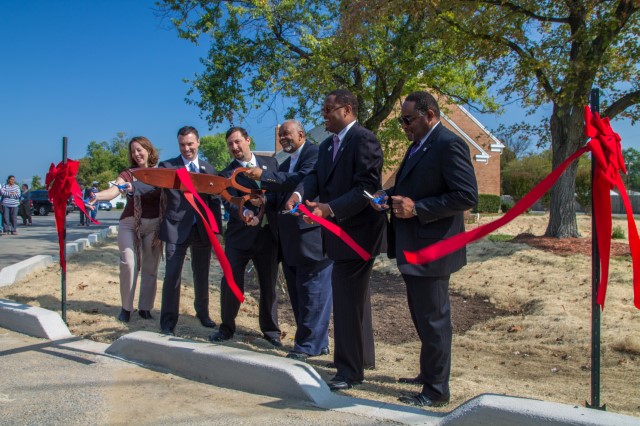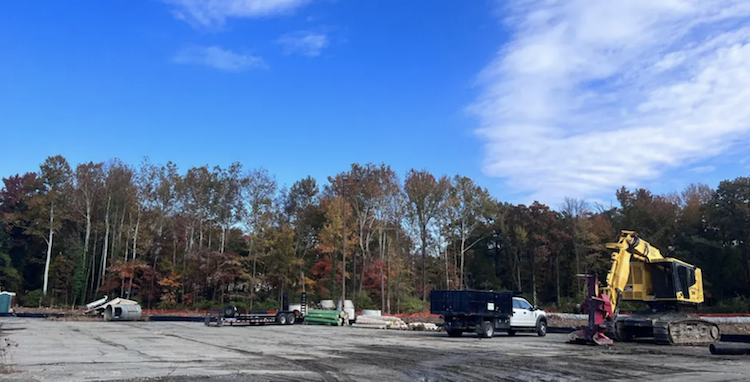Expert Urges Expanded Use of P3s to Protect Water Resources
October 1, 2015
Clean Water Partnership Cuts the Ribbon on Stormwater Runoff
January 6, 2016The National Council for Public Private Partnerships
01/04/2016
Some states and localities are being compelled to spend millions of dollars to meet federal requirements to prevent polluted stormwater runoff and sewer system overflows from reaching major waterways — or pay hefty fines for noncompliance.
Rhode Island, for example, is under a federal consent decree to belatedly clean or repair about 25,000 stormwater catch basins on state roads, 3,800 outfalls and 100 other treatment systems, to prevent polluted runoff from reaching 235 bodies of water that flow into Narragansett and Mount Hope bays. In addition to paying $112 million over 10 years for the cleanup, the state’s transportation department will also pay $315,000 in civil penalties for failing to take such measures more than a decade after a stormwater discharge permit had been issued requiring them, the Providence Journal reported Dec. 22.
In the past, so-called direct or “point source” producers of pollution — such as wastewater plants and ships — were identified as the main threat to public water quality. Because many of these deficiencies have been addressed, today states have identified nonpoint sources — stormwater runoff from urban and agricultural sources — as by far the biggest culprit, according to the U.S. Environmental Protection Agency (EPA).
This type of pollution can be abated, however, through ecologically supportive construction and maintenance or “green infrastructure” projects in both the natural and the built environments. Coastal wetlands capture sediments and other pollutants from stormwater, for example, while the installation of green roofs, rain gardens and permeable pavements can absorb runoff in urban and suburban areas, the Horinko Group explained in a recent report on green infrastructure solutions written for the Conservation Leadership Council.
Government-run efforts to install and maintain green infrastructure projects often are hampered by a lack of funding, staffing and expertise. One solution involves negotiating agreements with private partners to provide this assistance. The involvement of private partners not only can help states and localities address funding and resource shortfalls but help them conduct projects more efficiently than many agencies can do on their own.
“Green infrastructure projects are normally addressed in a piecemeal approach, with each project going through a separate process of planning, design, construction and inspection/maintenance; rarely are these services integrated,” the Horinko Group pointed out in its report. “This leads to inflated costs due to inefficiencies in project delivery”
A P3 approach allows most or all of these services to be delivered by a single firm or team, increasing efficiency. The private sector’s ability to provide significant financing allows for the development of large projects, which permits volume purchasing and other practices that further improve efficiency and lower costs.
Recognizing the benefits agencies and the communities they serve can achieve through the P3 procurement approach, EPA published a guide on a green infrastructure development model, the Community-Based Public Private Partnerships (CBP3) for green infrastructure projects. In addition to encouraging the negotiation of P3s — specifically, the design-build-finance-operate-maintain model — to stormwater management, the CBP3 approach emphasizes that a chief goal of these partnerships must be to produce projects that contribute to local employment.
“A hallmark of the CBP3 approach is the long-term commitment between the public and private partners, as well as the partnership’s relationship with community stakeholders,” the guide states. “This long-term commitment allows the private partner to cultivate and develop local businesses and industries supporting the GI sector through stewardship and economic development of small and disadvantaged businesses.”
The challenges communities face in working to manage stormwater and potential solutions, including the CBP3 model, were discussed during a day-long December meeting, the CBP3 Sustainable Stormwater Infrastructure Summit. NCPPP cohosted the event with EPA, in partnership with the Water Environment Federation, the Chesapeake Bay Trust and the Pennsylvania Water Environment Association.
Attendees included staff members from EPA Region 3, members of communities working to improve their stormwater management strategies and representatives of private firms that wish to participate in such projects. Topics ranged from the types of public financing available for such projects to emerging technologies to monitor and improve their performance. Attendees from communities that have embarked on or are considering CBP3s also described the challenges they face in ensuring that they can successfully conduct projects.
The summit’s participants learned useful information about P3s and the CBP3 model from an array of experts. They heard, for example, that states can use funds provided by EPA to make and guarantee loans and in other ways — including P3s — subsidize stormwater management projects through the Clean Water State Revolving Fund (CWSRF) program.
Unfortunately, the officials who are administering these funds “and their stakeholders are not capitalizing on state revolving fund (SRF) financial tools to leverage public and private capital in new ways,” said James Gebhardt, senior advisor to the deputy administrator for water finance and director of the EPA Finance and Resiliency Center, in his presentation on SRFs.
States and localities must come to grips with this challenge because, as Rhode Island’s example illustrates, EPA is seeing unacceptable stormwater management compliance rates and is working to hold states and communities accountable. Communities will be expected not just to maintain current performance levels but improve them, warned Jon Capacasa, director of the Water Protection Division for EPA Region 3.
The agency wants to see communities move away from solutions that are designed solely to avoid or address consent decrees or other regulatory pressures, toward “cost-effective solutions through P3s and self-audits,” Capacasa said. “The goal is to get communities staying in compliance on their own.”
The enormous potential for new technologies to help communities improve stormwater management was also discussed during the summit. One example is OptiRTC, Inc.’s use of sensors and valves, coupled with weather forecasts and cloud-based technology, to continuously monitor stormwater infrastructure performance and improve it by, for example, controlling how much water is stored or released from containment structures in response to changing conditions, Marcus Quigley, the company’s chief executive officer, explained.
Appropriate technology use is important in P3 stormwater projects, because accurate performance data can support a pay-for-performance contract and lower maintenance costs while improving capital expenditure forecasts, Quigley pointed out.
The summit featured a detailed description of a pioneering CBP3 project being conducted in Prince George’s County, Md., to prevent polluted stormwater from entering the Chesapeake Bay and its tributaries, a challenge that involves communities in six states and the District of Columbia.
Corvias Solutions is conducting this $100 million green infrastructure retrofit with the county’s Department of the Environment. In the first phase, Corvias is retrofitting 2,000 acres of public and private land with stormwater management infrastructure over three years to help the county comply with its Municipal Separate Storm Sewer System (MS4) permit requirements.
The county’s ultimate goal is to convert 15,000 acres of impervious surfaces into surfaces that soak up or treat rainwater, primarily by installing 46,000 stormwater devices, such as rain gardens, cisterns and permeable pavements. If Corvias meets its target of retrofitting 2,000 acres by 2017, the company will take on an additional 2,000 acres and has committed to maintaining all of the assets it improves for 30 years.
The private team’s performance is being measured against that of government counterparts. The county has its own team of employees working on a similar stormwater retrofit project with similar timeframes, which allows the two groups to compare approaches, results and lessons learned. Adam Ortiz, director of the county’s Department of the Environment, predicted that although the county’s team has 30 years of environmental experience, Corvias will make quicker progress and, in fact, already is doing so. Eight months after project initiation, Corvias has 78 projects in design and 16 in construction, he reported, compared with the county team’s 37 projects in design and three in construction.
Corvias is receiving availability payments for reaching certain milestones, which range from meeting construction deadlines to ensuring that local residents will comprise 15 percent of the workforce in year one and reach 50 percent by the end of year three. The firm already has well exceeded that goal, Greg Cannito, managing director of Corvias Group, said.
“We have contracted $5.7 million in work to small contractors, 85 percent of whom are minority, women and small businesses,” Cannito said.
The firm also mentors subcontractors, teaching them how to write proposals and get certified as small disadvantaged businesses, and is training local businesses, the workforce and students who may go into the stormwater arena as engineers or in other roles.
“We do this to help them and because we need them,” he added.
Corvias also is committed to working with local nonprofits and church groups to retrofit private properties and is exploring partnering with local schools on this CBP3. “Corvias is part of our family and will be for a long time,” Ortiz said.
The topics discussed during the CBP3 Sustainable Stormwater Infrastructure Summit and many of the points highlighted in the Horinko Group’s report are discussed in-depth in the above-mentioned CBP3 guide for local communities. This document provides a thorough discussion of the traditional P3 model and the ways in which the CBP3 aligns with and differs from it. The guide also covers financing strategies and approaches, how to determine whether a CBP3 approach is appropriate for a particular project and the availability of alternative market-based tools, such as Washington, D.C.’s stormwater retention credit trading program.
In considering the types of projects that could be developed through CBP3s, state and local decision makers should be flexible, inventive and open to ways to affect and improve a variety of infrastructure, Dominique Lueckenhoff, Deputy Director of EPA Region 3’s Water Protection Division, said at the summit.
“Green streets and green highways are projects that combine water with road infrastructure,” Lueckenhoff said. “These can save 40 percent to 60 percent in public-private dollars when they’re aligned.”
She also stressed that the P3 approach to procuring green infrastructure should focus not just on the lowest bid but on the long-term quality and performance of the project.
The CBP3 model, meanwhile, “focuses on community involvement, on fostering long-term resiliency and on growing a family.”



